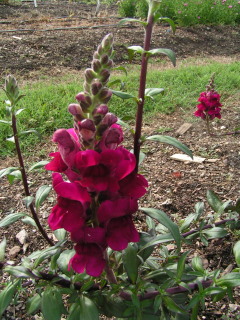Antirrhinum ‘Potomac Crimson’
go.ncsu.edu/readext?221460
en Español / em Português
El inglés es el idioma de control de esta página. En la medida en que haya algún conflicto entre la traducción al inglés y la traducción, el inglés prevalece.
Al hacer clic en el enlace de traducción se activa un servicio de traducción gratuito para convertir la página al español. Al igual que con cualquier traducción por Internet, la conversión no es sensible al contexto y puede que no traduzca el texto en su significado original. NC State Extension no garantiza la exactitud del texto traducido. Por favor, tenga en cuenta que algunas aplicaciones y/o servicios pueden no funcionar como se espera cuando se traducen.
Português
Inglês é o idioma de controle desta página. Na medida que haja algum conflito entre o texto original em Inglês e a tradução, o Inglês prevalece.
Ao clicar no link de tradução, um serviço gratuito de tradução será ativado para converter a página para o Português. Como em qualquer tradução pela internet, a conversão não é sensivel ao contexto e pode não ocorrer a tradução para o significado orginal. O serviço de Extensão da Carolina do Norte (NC State Extension) não garante a exatidão do texto traduzido. Por favor, observe que algumas funções ou serviços podem não funcionar como esperado após a tradução.
English
English is the controlling language of this page. To the extent there is any conflict between the English text and the translation, English controls.
Clicking on the translation link activates a free translation service to convert the page to Spanish. As with any Internet translation, the conversion is not context-sensitive and may not translate the text to its original meaning. NC State Extension does not guarantee the accuracy of the translated text. Please note that some applications and/or services may not function as expected when translated.
Collapse ▲Trial: Annual
Year Trialed: 2009

Good Qualities
Rich color (4); This was an outstanding color, dark, rich and velvety and lauded by all who saw it, decent plant vigor and stem quality; All the snaps I trialed had no disease problems and we were wet this summer and I didn’t need to spray anything on them; More of a rosy red than the ‘Opus’, beautiful red colored stems; Stems were strong, bloomed all season.
Problems
Later stems were somewhat more brittle than the first waves; Rust.
Similar Cultivars
Nice and full like other Potomac varieties; Other Potomac snaps.
Postharvest
Cut early in the day, kept cool and also used Floralife, strip bottom foliage before putting into buckets, seems to help with absorption; None.
Trial Data
| Yield (stems/plant) | Stem Length (inches) | Market Appreciation Rating¹ | Repeat Again Rating¹ | Ease of Cultivation Rating¹ | Average Spacing (in2) | Average Postharvest Life (days) | |||
|---|---|---|---|---|---|---|---|---|---|
| Wholesale | Retail | Consumer | |||||||
| Average | 8.9 | 21.9 | 4.0 | 4.5 | 4.6 | 5.0 | 4.6 | 88.9 | 10.0 |
| Range of Responses | 4-15 | 15-36 | 4-5 | 4-5 | 4-5 | 4-5 | 4-5 | 36-144 | 10 |
¹1 to 5 scale, with 5 being the best. Market ratings are based on sales to wholesalers, retailers, or final consumers direct.
Supplier
Ball Horticultural
P.O. Box 438
West Chicago, IL 60186



Comments
Pinched plants; Harvested 7/1-7/8 (planted in the field 4/25, Zone 5).